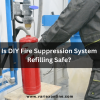![]()
Fire Immuniser
+91-7829629111
Email: info@variex.in
Varistor Technologies Pvt. Ltd.
Block-1, First Floor, Ardente Office One, Hoodi Circle, ITPL Main Road, Bengaluru, Karnataka 560048, IN
Clean Agent Fire Extinguisher Refilling
Clean Agent Fire Extinguisher Refilling
Fire extinguishers are essential safety devices that help prevent the spread of fires and protect lives and property. One type of fire extinguisher that has gained popularity in recent years is the clean agent fire extinguisher. Unlike traditional extinguishers that use water or other chemicals, clean agent fire extinguishers use non-conductive and non-corrosive gases to put out fires. However, to ensure these extinguishers function properly when needed, it is crucial to regularly refill them. This article will guide you through the process of clean agent fire extinguisher refilling.
Understanding Clean Agent Fire Extinguishers
Clean agent fire extinguishers are commonly used in enclosed spaces such as computer rooms, data centers, libraries, museums, and offices because they do not leave any residue or cause damage to sensitive equipment or belongings. They are specifically designed to extinguish fires involving electrical equipment safely. The most commonly used clean agents include halocarbon-based and inert gas-based extinguishing agents.
Halocarbon-based agents, such as HFC-227ea (FM-200) and CF3I (Novec 1230), are known for their excellent performance and low environmental impact. These agents work by removing heat from the fire equation and interrupting the chemical chain reactions needed for combustion. On the other hand, inert gas-based agents, like nitrogen and argon, work by displacing oxygen, reducing its concentration and consequently suffocating the fire.
Why Refilling is Necessary
While clean agent fire extinguishers do not leave a residue, they are typically filled with pressurized gas. Over time, this gas may leak, reducing the extinguisher's effectiveness. Additionally, changes in temperature and pressure can also impact the gas inside the extinguisher. Therefore, regular refilling ensures that the extinguisher is always ready to combat fires and effectively protect the surrounding area.
It is essential to note that refilling clean agent fire extinguishers should only be done by trained professionals. Attempting to refill an extinguisher without the proper knowledge and equipment can be extremely dangerous and may lead to malfunctioning or even explosion.
The Refilling Process
Professional fire extinguisher technicians follow a specific process to refill clean agent fire extinguishers. Here are the general steps involved:
- Inspection: Before initiating the refilling process, the technician inspects the extinguisher for any damage, corrosion, or other issues that may affect its ability to function correctly.
- Discharge: If the extinguisher is not empty, the technician carefully discharges the remaining gas in a controlled environment to ensure the safety of everyone nearby.
- Purging: After discharging the agent, the technician follows a purging procedure to remove any residual gas or impurities from the extinguisher.
- Refill: The technician refills the extinguisher with the appropriate clean agent, using the correct pressure and weight specifications.
- Pressure Testing: After refilling, the extinguisher is subjected to a pressure test to ensure it can safely and effectively function in case of a fire emergency.
- Reassembly: Once the pressure test is passed, the technician reassembles the extinguisher, ensuring all components are securely in place.
- Tagging and Documentation: Finally, the technician tags the extinguisher with the refill date, technician's details, and any other necessary information. They also update the maintenance records for future reference.
Maintenance Schedule
It is crucial to follow a regular maintenance schedule for clean agent fire extinguishers to ensure their reliability. Typically, these extinguishers require an annual maintenance check, which includes inspection, refilling, and pressure testing. Additionally, most authorities recommend a complete refill and service every 5 to 10 years, depending on the manufacturer's guidelines.
If an extinguisher has been discharged, even partially, it should be refilled immediately to ensure it is ready for use in case of an emergency.
Conclusion
Clean agent fire extinguishers are a vital tool in fire protection, particularly in environments with sensitive equipment. Regular refilling of clean agent fire extinguishers ensures their effectiveness and longevity. By following the proper refilling process and adhering to maintenance schedules, you can be confident that these extinguishers will operate flawlessly when needed, helping protect lives and property.
Final Say
We at VariEx.in or Variexonline.com have mastered the art of designing, installing, inspecting, and fixing automatic sprinkler systems with the help of our in-house team, which is capable of delivering the fire sprinkler services you need, whether large or small and at affordable cost.
To schedule a fire sprinkler installation, or you think our services could benefit your commercial property, contact us online or give us a call at, 7829629111









